I have been doing some preliminary research for my next book which will focus on the glider missions in Bastogne. When I was in the initial stages of the idea rolling around in my head I was honored to meet a Pathfinder at a book signing who was incredibly informative and put me in connection with other Pathfinders. I am honored to be in contact with this select group who were a key part in the glider missions.
In the meantime was asked to write an article, part of which discussed the glider Varsity mission in March 1945. I discovered in my research that the Pathfinders did not clear the landing zones for the gliders in that mission. Instead Combat Control Teams who were outfitted with the latest in navigation aids and operated as air traffic control flew in on gliders. This, the last glider mission of the war, is where the red glider made its debut flown by 1st Lt. Norman Wilmeth, a glider pilot and a member of the Combat Control Team (CCT) and his copilot Flight Officer Leon Rounds, also a glider pilot and member of the CCT. A jeep was being loaded in his glider which was not secured properly. The glider was damaged by the shifting jeep prior to the glider tow and the glider was not flyable.
By this time in in the war there was always a need for more gliders. Gliders were originally intended to be a one time use aircraft but by Normandy in the ETO gliders that were deemed salvageable were picked up via a snatch up method. Very simplified the snatch up method involved a C-47 flying over at low altitude and with a hook type apparatus snatching the glider tow rope and pulling the glider into flight behind it. This method was originally used in the China Burma Theater to evacuate wounded soldiers. Gliders were reclaimed in Normandy, Market - Garden and Varsity. The same method used in the CBI to evacuate wounded soldiers was used in Remagen to evacuate the wounded.
There were many reasons gliders were not salvageable. They were extremely flammable and often were hit by mortars after landing, the freshly landed gliders were cannibalized by glider pilots and airborne troops for the outer fabric covering to line their foxholes with, for souvenirs or by locals for plywood benches, instrument panels and anything deemed useful in the situation the war had left them in. Many gliders were also destroyed upon landing. Gliders that were reclaimed that deemed flyable enough to tow them even with ripped exteriors or tail flutters. Many complaints were made by the glider pilots who had to fly reclaimed gliders on subsequent missions. Not all were returned to their original state. Lt. Wilmeth and F/O Rounds found themselves in a tight situation when their new glider was not flyable due to damage from the jeep and no other gliders were available.
With the help of a glider mechanic they ended up finding a glider that had been “repaired” but the final application of paint had not been applied. In desperate need of a glider they took it. However it had not received its final green combat paint so they accepted it and flew a red primed glider into Germany
The final coat of paint was not the only issue with the glider - a serious tail flutter developed that took both the pilot and the copilot Flight Officer Leon Rounds to control the glider. One wonders what the Germans though when they saw one red glider among all the others. Perhaps they realized it had not had its final coat of paint - perhaps not.





At the Silent Wings museum exhibits we also learned about the 'workshop' that would fit into a Waco glider and when landed could be opened up to find just about everything needed to repair gliders in the field for return to the rear area for reuse. In Operation Varsity, as I recall, the operational concept was to use the airborne forces pretty much just across the river (the Rhine) to establish a bridgehead that would be immediately 'relieved' by the regular forces crossing the Rhine in amphibious craft and soon to be built bridges (the airborne forces having in theory pushed the Germans back far enough to allow the engineers to concentrate on bridge building rather than fighting.